Leadership and Management Report: Fonterra Change and Innovation
VerifiedAdded on 2020/04/21
|22
|5693
|47
Report
AI Summary
This report provides a comprehensive analysis of leadership and management practices within Fonterra, a prominent dairy industry organization in New Zealand. It delves into stakeholder relationship management, exploring the importance of strategic relationships in facilitating change and innovation, and examines the consequences of poor relationship management. The report also addresses change and communication strategies, outlining reasons for change, short and long-term benefits, and innovation strategies. Furthermore, it investigates stakeholder engagement, staff motivation, and the role of managers in supporting change and innovation. The study highlights strategies for motivating stakeholders, supporting staff, and seeking feedback, while also assessing strategies for staff acceptance of change and ensuring self-motivation. The report utilizes Fonterra's Human Resource department as a case study, offering insights into effective leadership and management techniques in the dairy industry.
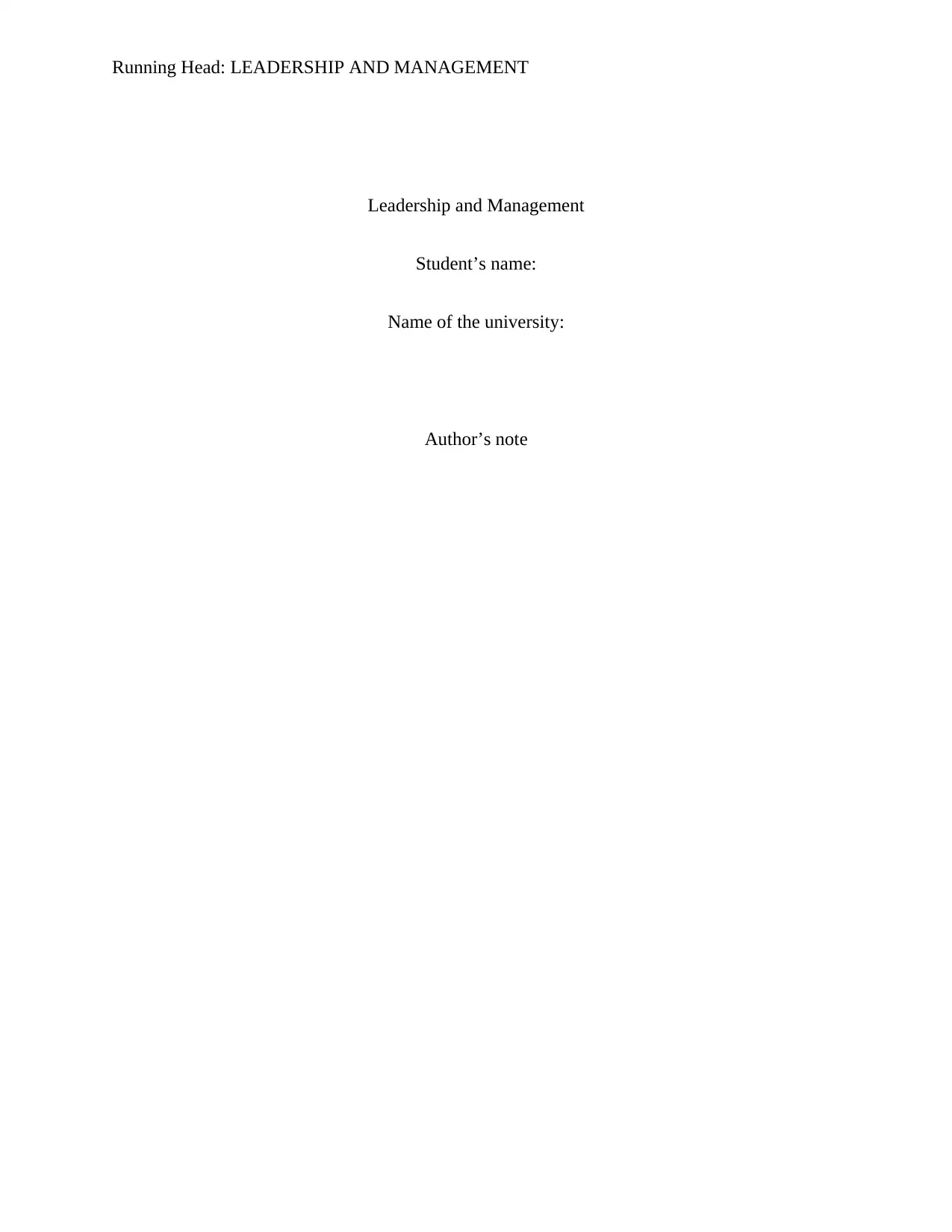
Running Head: LEADERSHIP AND MANAGEMENT
Leadership and Management
Student’s name:
Name of the university:
Author’s note
Leadership and Management
Student’s name:
Name of the university:
Author’s note
Paraphrase This Document
Need a fresh take? Get an instant paraphrase of this document with our AI Paraphraser
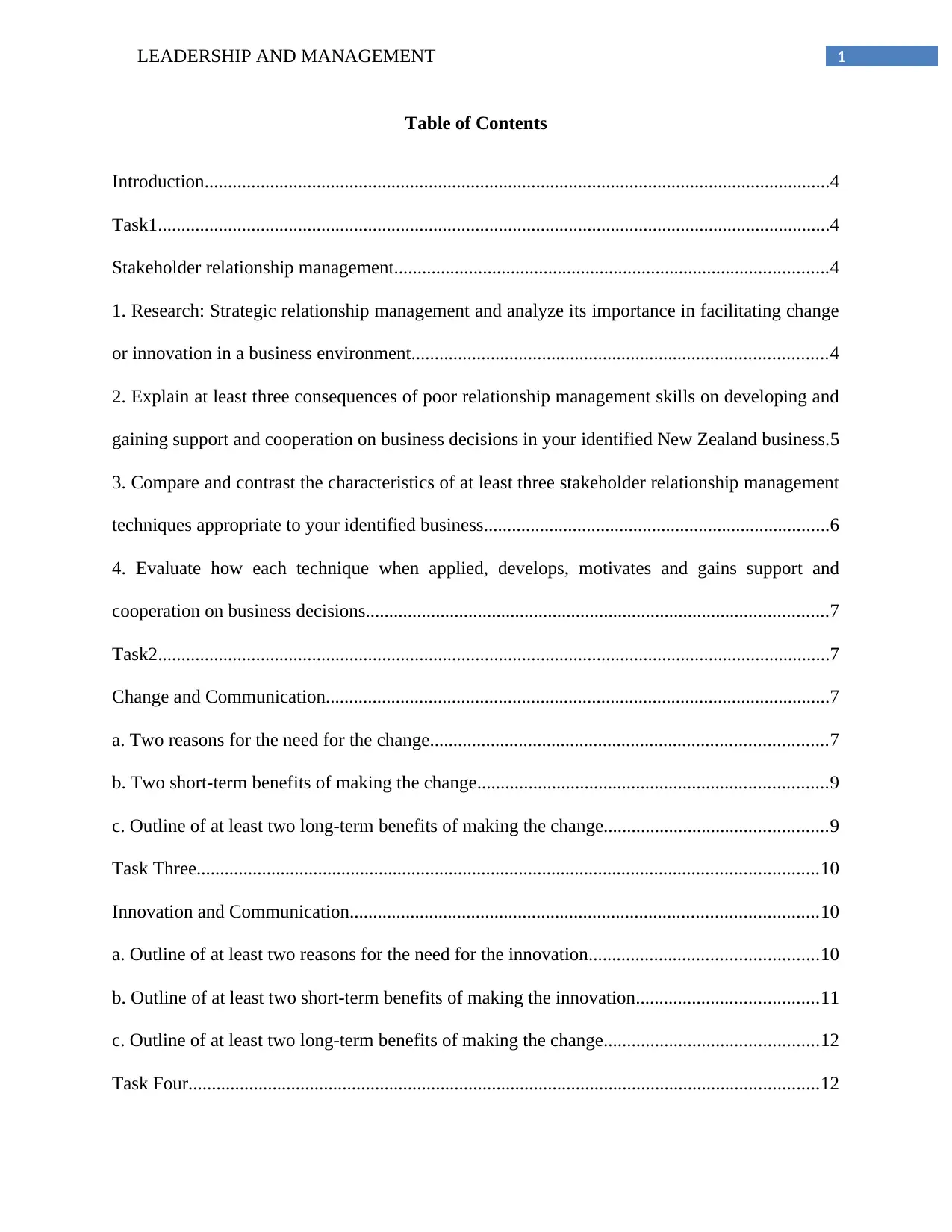
1LEADERSHIP AND MANAGEMENT
Table of Contents
Introduction......................................................................................................................................4
Task1................................................................................................................................................4
Stakeholder relationship management.............................................................................................4
1. Research: Strategic relationship management and analyze its importance in facilitating change
or innovation in a business environment.........................................................................................4
2. Explain at least three consequences of poor relationship management skills on developing and
gaining support and cooperation on business decisions in your identified New Zealand business.5
3. Compare and contrast the characteristics of at least three stakeholder relationship management
techniques appropriate to your identified business..........................................................................6
4. Evaluate how each technique when applied, develops, motivates and gains support and
cooperation on business decisions...................................................................................................7
Task2................................................................................................................................................7
Change and Communication............................................................................................................7
a. Two reasons for the need for the change.....................................................................................7
b. Two short-term benefits of making the change...........................................................................9
c. Outline of at least two long-term benefits of making the change................................................9
Task Three.....................................................................................................................................10
Innovation and Communication....................................................................................................10
a. Outline of at least two reasons for the need for the innovation.................................................10
b. Outline of at least two short-term benefits of making the innovation.......................................11
c. Outline of at least two long-term benefits of making the change..............................................12
Task Four.......................................................................................................................................12
Table of Contents
Introduction......................................................................................................................................4
Task1................................................................................................................................................4
Stakeholder relationship management.............................................................................................4
1. Research: Strategic relationship management and analyze its importance in facilitating change
or innovation in a business environment.........................................................................................4
2. Explain at least three consequences of poor relationship management skills on developing and
gaining support and cooperation on business decisions in your identified New Zealand business.5
3. Compare and contrast the characteristics of at least three stakeholder relationship management
techniques appropriate to your identified business..........................................................................6
4. Evaluate how each technique when applied, develops, motivates and gains support and
cooperation on business decisions...................................................................................................7
Task2................................................................................................................................................7
Change and Communication............................................................................................................7
a. Two reasons for the need for the change.....................................................................................7
b. Two short-term benefits of making the change...........................................................................9
c. Outline of at least two long-term benefits of making the change................................................9
Task Three.....................................................................................................................................10
Innovation and Communication....................................................................................................10
a. Outline of at least two reasons for the need for the innovation.................................................10
b. Outline of at least two short-term benefits of making the innovation.......................................11
c. Outline of at least two long-term benefits of making the change..............................................12
Task Four.......................................................................................................................................12
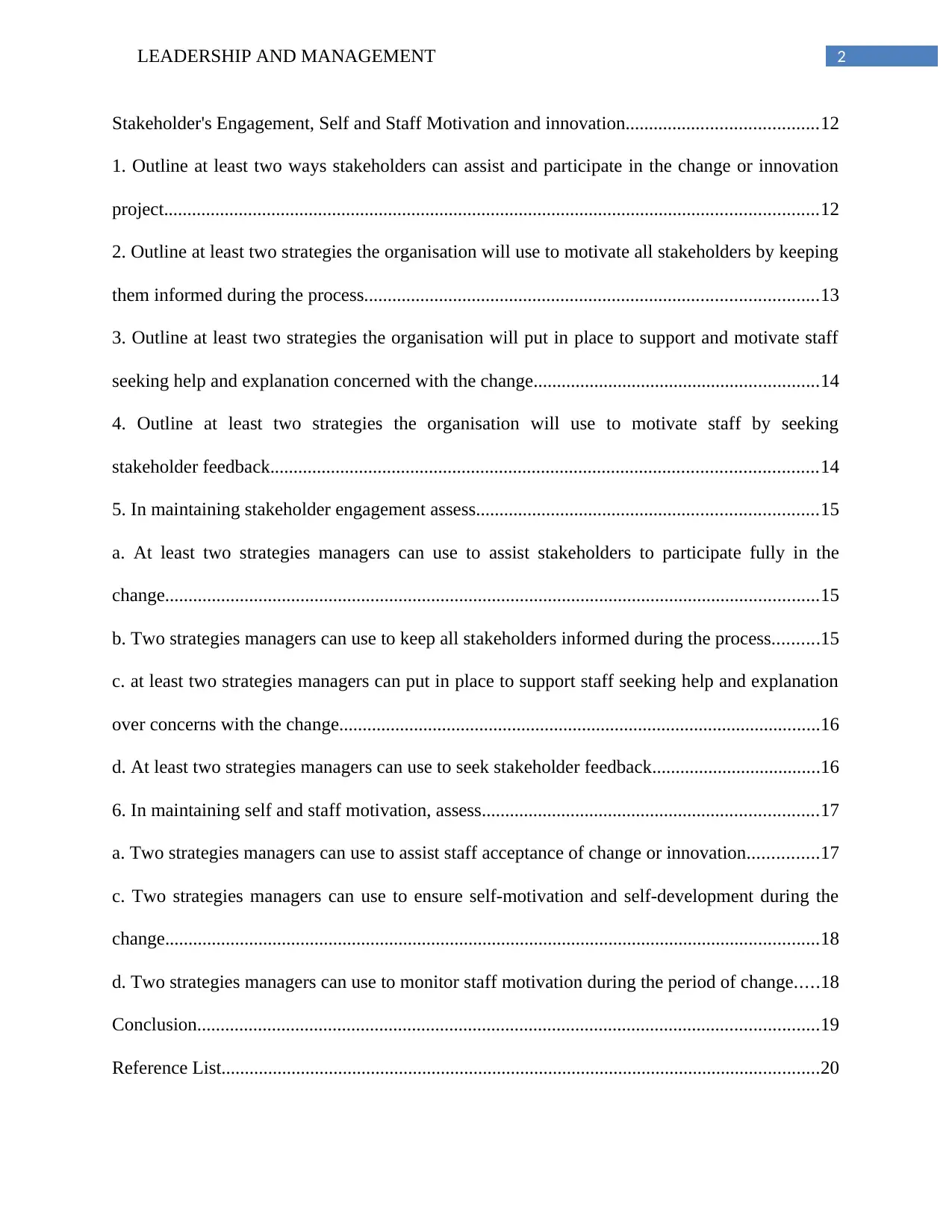
2LEADERSHIP AND MANAGEMENT
Stakeholder's Engagement, Self and Staff Motivation and innovation.........................................12
1. Outline at least two ways stakeholders can assist and participate in the change or innovation
project............................................................................................................................................12
2. Outline at least two strategies the organisation will use to motivate all stakeholders by keeping
them informed during the process.................................................................................................13
3. Outline at least two strategies the organisation will put in place to support and motivate staff
seeking help and explanation concerned with the change.............................................................14
4. Outline at least two strategies the organisation will use to motivate staff by seeking
stakeholder feedback.....................................................................................................................14
5. In maintaining stakeholder engagement assess.........................................................................15
a. At least two strategies managers can use to assist stakeholders to participate fully in the
change............................................................................................................................................15
b. Two strategies managers can use to keep all stakeholders informed during the process..........15
c. at least two strategies managers can put in place to support staff seeking help and explanation
over concerns with the change.......................................................................................................16
d. At least two strategies managers can use to seek stakeholder feedback....................................16
6. In maintaining self and staff motivation, assess........................................................................17
a. Two strategies managers can use to assist staff acceptance of change or innovation...............17
c. Two strategies managers can use to ensure self-motivation and self-development during the
change............................................................................................................................................18
d. Two strategies managers can use to monitor staff motivation during the period of change.....18
Conclusion.....................................................................................................................................19
Reference List................................................................................................................................20
Stakeholder's Engagement, Self and Staff Motivation and innovation.........................................12
1. Outline at least two ways stakeholders can assist and participate in the change or innovation
project............................................................................................................................................12
2. Outline at least two strategies the organisation will use to motivate all stakeholders by keeping
them informed during the process.................................................................................................13
3. Outline at least two strategies the organisation will put in place to support and motivate staff
seeking help and explanation concerned with the change.............................................................14
4. Outline at least two strategies the organisation will use to motivate staff by seeking
stakeholder feedback.....................................................................................................................14
5. In maintaining stakeholder engagement assess.........................................................................15
a. At least two strategies managers can use to assist stakeholders to participate fully in the
change............................................................................................................................................15
b. Two strategies managers can use to keep all stakeholders informed during the process..........15
c. at least two strategies managers can put in place to support staff seeking help and explanation
over concerns with the change.......................................................................................................16
d. At least two strategies managers can use to seek stakeholder feedback....................................16
6. In maintaining self and staff motivation, assess........................................................................17
a. Two strategies managers can use to assist staff acceptance of change or innovation...............17
c. Two strategies managers can use to ensure self-motivation and self-development during the
change............................................................................................................................................18
d. Two strategies managers can use to monitor staff motivation during the period of change.....18
Conclusion.....................................................................................................................................19
Reference List................................................................................................................................20
⊘ This is a preview!⊘
Do you want full access?
Subscribe today to unlock all pages.

Trusted by 1+ million students worldwide
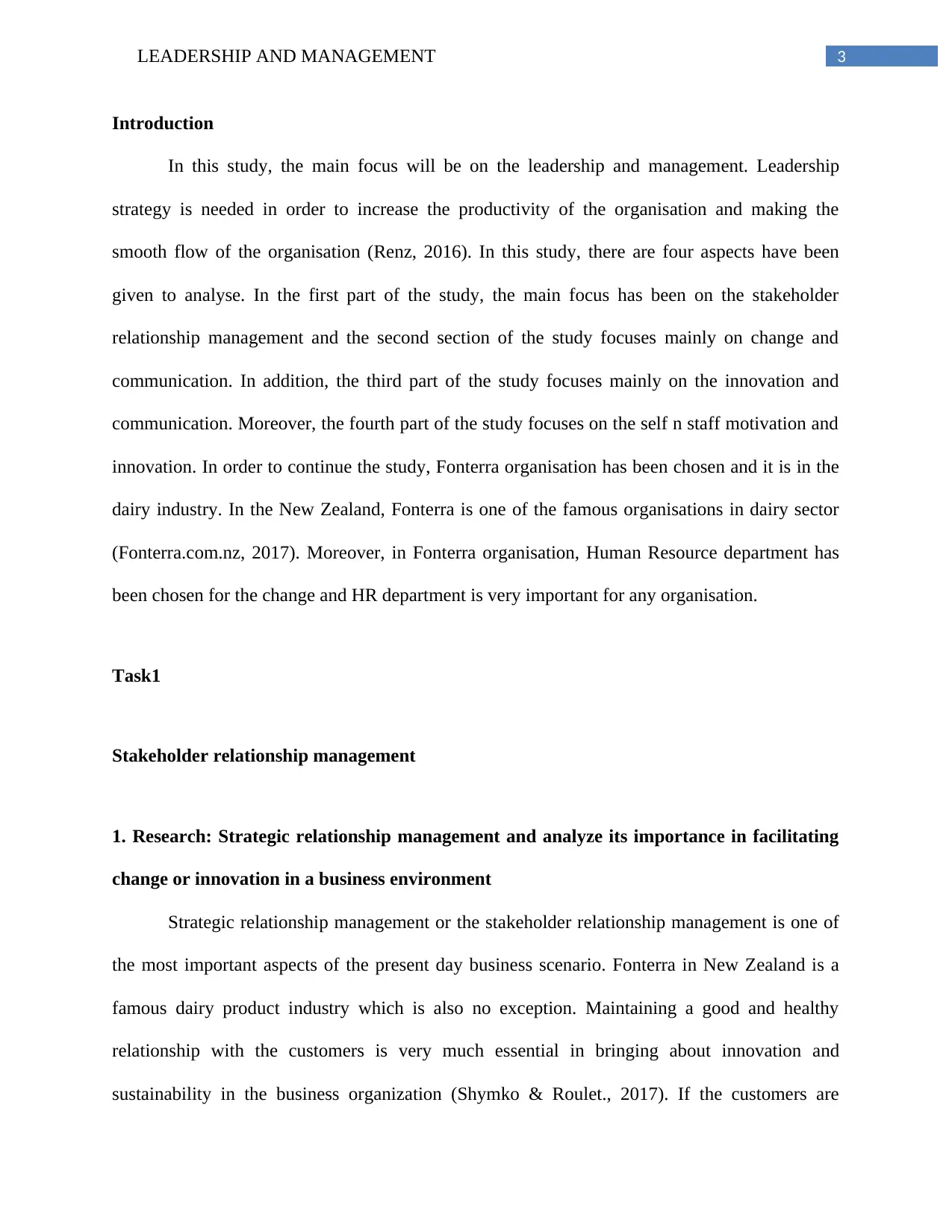
3LEADERSHIP AND MANAGEMENT
Introduction
In this study, the main focus will be on the leadership and management. Leadership
strategy is needed in order to increase the productivity of the organisation and making the
smooth flow of the organisation (Renz, 2016). In this study, there are four aspects have been
given to analyse. In the first part of the study, the main focus has been on the stakeholder
relationship management and the second section of the study focuses mainly on change and
communication. In addition, the third part of the study focuses mainly on the innovation and
communication. Moreover, the fourth part of the study focuses on the self n staff motivation and
innovation. In order to continue the study, Fonterra organisation has been chosen and it is in the
dairy industry. In the New Zealand, Fonterra is one of the famous organisations in dairy sector
(Fonterra.com.nz, 2017). Moreover, in Fonterra organisation, Human Resource department has
been chosen for the change and HR department is very important for any organisation.
Task1
Stakeholder relationship management
1. Research: Strategic relationship management and analyze its importance in facilitating
change or innovation in a business environment
Strategic relationship management or the stakeholder relationship management is one of
the most important aspects of the present day business scenario. Fonterra in New Zealand is a
famous dairy product industry which is also no exception. Maintaining a good and healthy
relationship with the customers is very much essential in bringing about innovation and
sustainability in the business organization (Shymko & Roulet., 2017). If the customers are
Introduction
In this study, the main focus will be on the leadership and management. Leadership
strategy is needed in order to increase the productivity of the organisation and making the
smooth flow of the organisation (Renz, 2016). In this study, there are four aspects have been
given to analyse. In the first part of the study, the main focus has been on the stakeholder
relationship management and the second section of the study focuses mainly on change and
communication. In addition, the third part of the study focuses mainly on the innovation and
communication. Moreover, the fourth part of the study focuses on the self n staff motivation and
innovation. In order to continue the study, Fonterra organisation has been chosen and it is in the
dairy industry. In the New Zealand, Fonterra is one of the famous organisations in dairy sector
(Fonterra.com.nz, 2017). Moreover, in Fonterra organisation, Human Resource department has
been chosen for the change and HR department is very important for any organisation.
Task1
Stakeholder relationship management
1. Research: Strategic relationship management and analyze its importance in facilitating
change or innovation in a business environment
Strategic relationship management or the stakeholder relationship management is one of
the most important aspects of the present day business scenario. Fonterra in New Zealand is a
famous dairy product industry which is also no exception. Maintaining a good and healthy
relationship with the customers is very much essential in bringing about innovation and
sustainability in the business organization (Shymko & Roulet., 2017). If the customers are
Paraphrase This Document
Need a fresh take? Get an instant paraphrase of this document with our AI Paraphraser
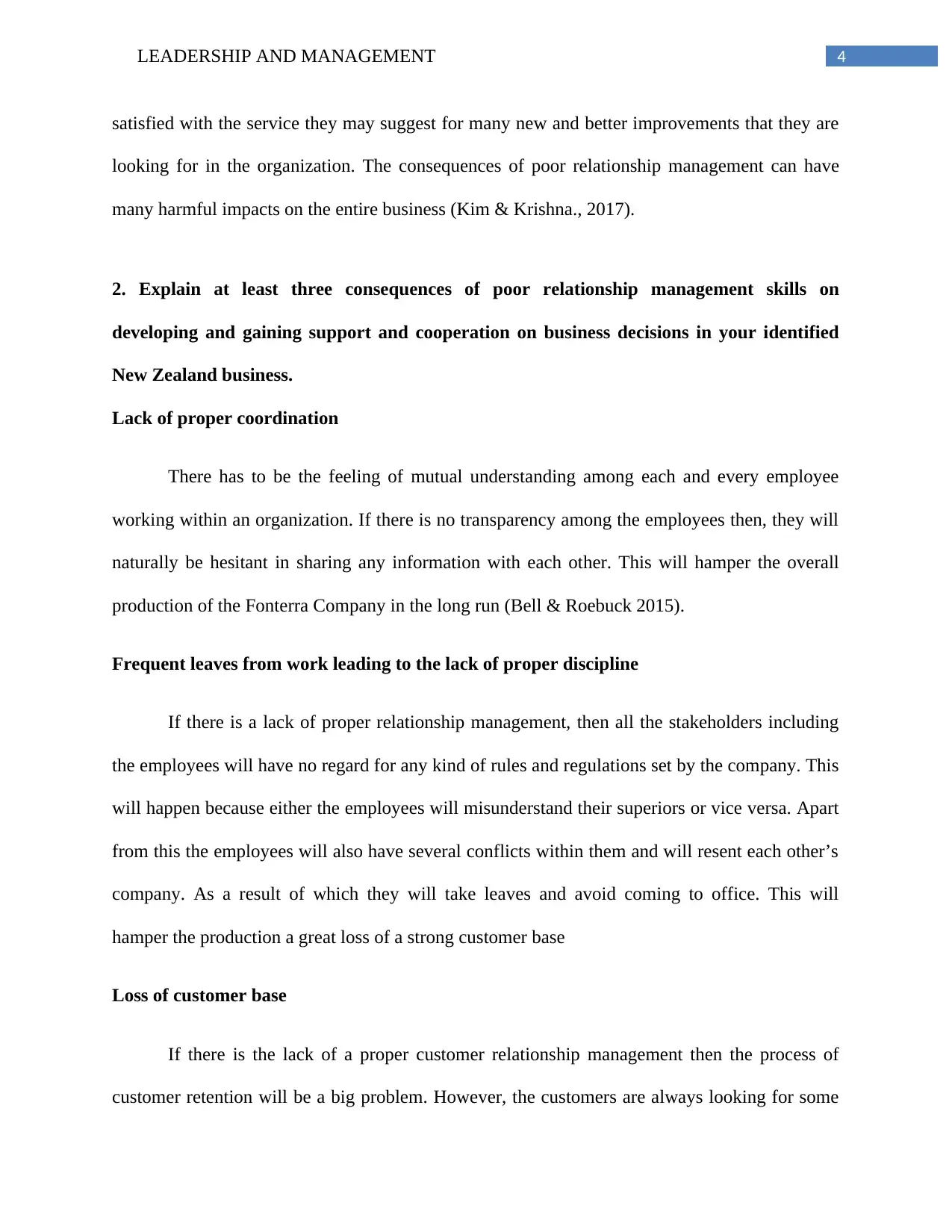
4LEADERSHIP AND MANAGEMENT
satisfied with the service they may suggest for many new and better improvements that they are
looking for in the organization. The consequences of poor relationship management can have
many harmful impacts on the entire business (Kim & Krishna., 2017).
2. Explain at least three consequences of poor relationship management skills on
developing and gaining support and cooperation on business decisions in your identified
New Zealand business.
Lack of proper coordination
There has to be the feeling of mutual understanding among each and every employee
working within an organization. If there is no transparency among the employees then, they will
naturally be hesitant in sharing any information with each other. This will hamper the overall
production of the Fonterra Company in the long run (Bell & Roebuck 2015).
Frequent leaves from work leading to the lack of proper discipline
If there is a lack of proper relationship management, then all the stakeholders including
the employees will have no regard for any kind of rules and regulations set by the company. This
will happen because either the employees will misunderstand their superiors or vice versa. Apart
from this the employees will also have several conflicts within them and will resent each other’s
company. As a result of which they will take leaves and avoid coming to office. This will
hamper the production a great loss of a strong customer base
Loss of customer base
If there is the lack of a proper customer relationship management then the process of
customer retention will be a big problem. However, the customers are always looking for some
satisfied with the service they may suggest for many new and better improvements that they are
looking for in the organization. The consequences of poor relationship management can have
many harmful impacts on the entire business (Kim & Krishna., 2017).
2. Explain at least three consequences of poor relationship management skills on
developing and gaining support and cooperation on business decisions in your identified
New Zealand business.
Lack of proper coordination
There has to be the feeling of mutual understanding among each and every employee
working within an organization. If there is no transparency among the employees then, they will
naturally be hesitant in sharing any information with each other. This will hamper the overall
production of the Fonterra Company in the long run (Bell & Roebuck 2015).
Frequent leaves from work leading to the lack of proper discipline
If there is a lack of proper relationship management, then all the stakeholders including
the employees will have no regard for any kind of rules and regulations set by the company. This
will happen because either the employees will misunderstand their superiors or vice versa. Apart
from this the employees will also have several conflicts within them and will resent each other’s
company. As a result of which they will take leaves and avoid coming to office. This will
hamper the production a great loss of a strong customer base
Loss of customer base
If there is the lack of a proper customer relationship management then the process of
customer retention will be a big problem. However, the customers are always looking for some
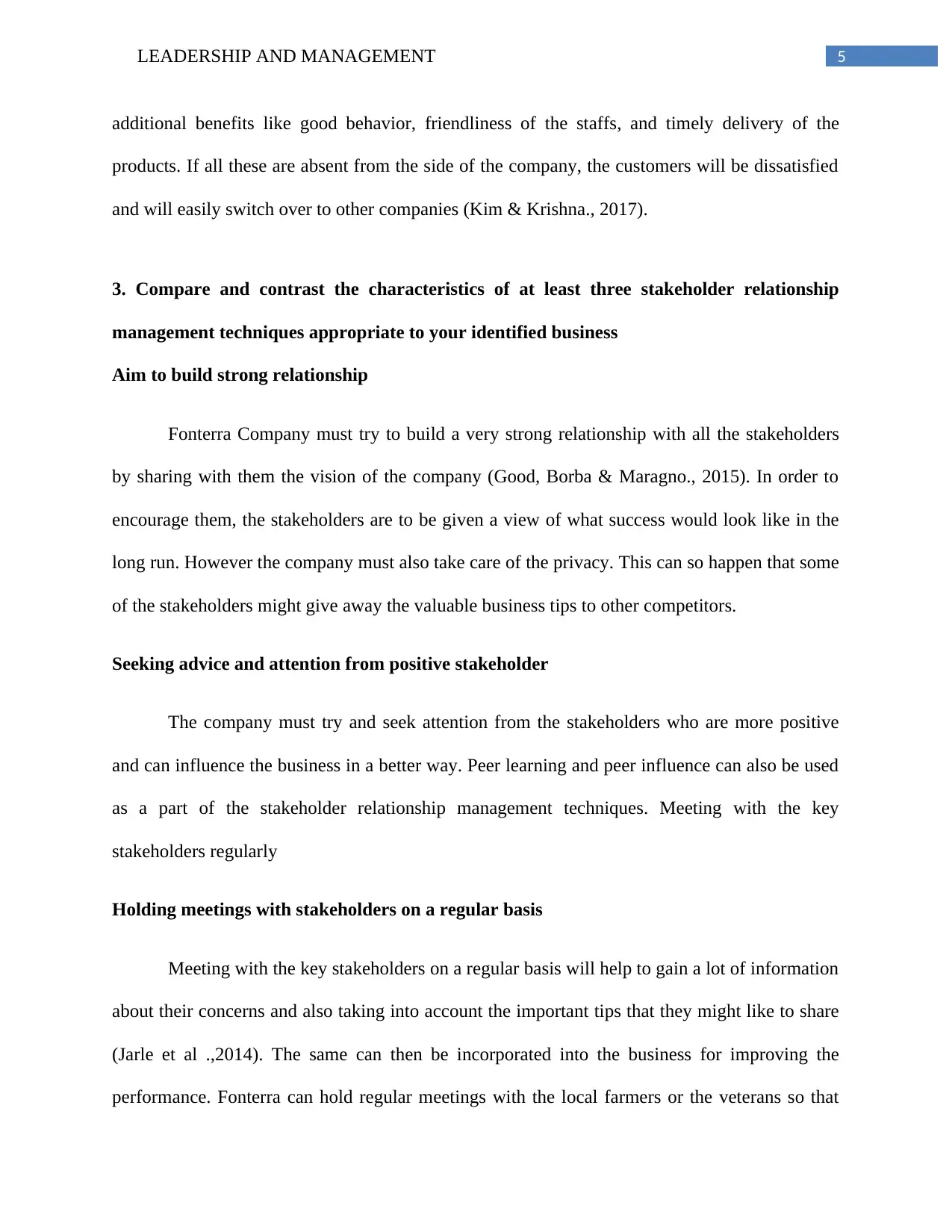
5LEADERSHIP AND MANAGEMENT
additional benefits like good behavior, friendliness of the staffs, and timely delivery of the
products. If all these are absent from the side of the company, the customers will be dissatisfied
and will easily switch over to other companies (Kim & Krishna., 2017).
3. Compare and contrast the characteristics of at least three stakeholder relationship
management techniques appropriate to your identified business
Aim to build strong relationship
Fonterra Company must try to build a very strong relationship with all the stakeholders
by sharing with them the vision of the company (Good, Borba & Maragno., 2015). In order to
encourage them, the stakeholders are to be given a view of what success would look like in the
long run. However the company must also take care of the privacy. This can so happen that some
of the stakeholders might give away the valuable business tips to other competitors.
Seeking advice and attention from positive stakeholder
The company must try and seek attention from the stakeholders who are more positive
and can influence the business in a better way. Peer learning and peer influence can also be used
as a part of the stakeholder relationship management techniques. Meeting with the key
stakeholders regularly
Holding meetings with stakeholders on a regular basis
Meeting with the key stakeholders on a regular basis will help to gain a lot of information
about their concerns and also taking into account the important tips that they might like to share
(Jarle et al .,2014). The same can then be incorporated into the business for improving the
performance. Fonterra can hold regular meetings with the local farmers or the veterans so that
additional benefits like good behavior, friendliness of the staffs, and timely delivery of the
products. If all these are absent from the side of the company, the customers will be dissatisfied
and will easily switch over to other companies (Kim & Krishna., 2017).
3. Compare and contrast the characteristics of at least three stakeholder relationship
management techniques appropriate to your identified business
Aim to build strong relationship
Fonterra Company must try to build a very strong relationship with all the stakeholders
by sharing with them the vision of the company (Good, Borba & Maragno., 2015). In order to
encourage them, the stakeholders are to be given a view of what success would look like in the
long run. However the company must also take care of the privacy. This can so happen that some
of the stakeholders might give away the valuable business tips to other competitors.
Seeking advice and attention from positive stakeholder
The company must try and seek attention from the stakeholders who are more positive
and can influence the business in a better way. Peer learning and peer influence can also be used
as a part of the stakeholder relationship management techniques. Meeting with the key
stakeholders regularly
Holding meetings with stakeholders on a regular basis
Meeting with the key stakeholders on a regular basis will help to gain a lot of information
about their concerns and also taking into account the important tips that they might like to share
(Jarle et al .,2014). The same can then be incorporated into the business for improving the
performance. Fonterra can hold regular meetings with the local farmers or the veterans so that
⊘ This is a preview!⊘
Do you want full access?
Subscribe today to unlock all pages.

Trusted by 1+ million students worldwide
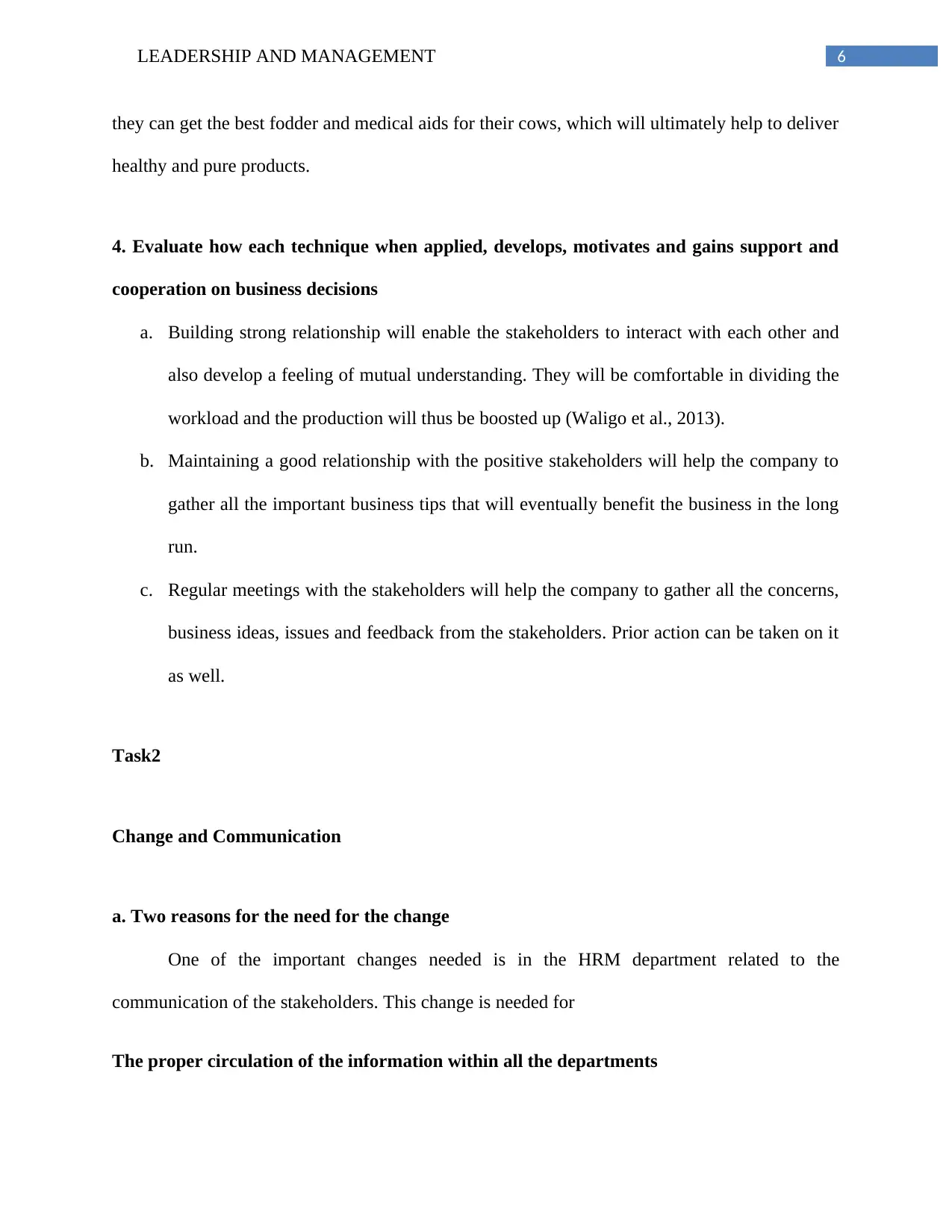
6LEADERSHIP AND MANAGEMENT
they can get the best fodder and medical aids for their cows, which will ultimately help to deliver
healthy and pure products.
4. Evaluate how each technique when applied, develops, motivates and gains support and
cooperation on business decisions
a. Building strong relationship will enable the stakeholders to interact with each other and
also develop a feeling of mutual understanding. They will be comfortable in dividing the
workload and the production will thus be boosted up (Waligo et al., 2013).
b. Maintaining a good relationship with the positive stakeholders will help the company to
gather all the important business tips that will eventually benefit the business in the long
run.
c. Regular meetings with the stakeholders will help the company to gather all the concerns,
business ideas, issues and feedback from the stakeholders. Prior action can be taken on it
as well.
Task2
Change and Communication
a. Two reasons for the need for the change
One of the important changes needed is in the HRM department related to the
communication of the stakeholders. This change is needed for
The proper circulation of the information within all the departments
they can get the best fodder and medical aids for their cows, which will ultimately help to deliver
healthy and pure products.
4. Evaluate how each technique when applied, develops, motivates and gains support and
cooperation on business decisions
a. Building strong relationship will enable the stakeholders to interact with each other and
also develop a feeling of mutual understanding. They will be comfortable in dividing the
workload and the production will thus be boosted up (Waligo et al., 2013).
b. Maintaining a good relationship with the positive stakeholders will help the company to
gather all the important business tips that will eventually benefit the business in the long
run.
c. Regular meetings with the stakeholders will help the company to gather all the concerns,
business ideas, issues and feedback from the stakeholders. Prior action can be taken on it
as well.
Task2
Change and Communication
a. Two reasons for the need for the change
One of the important changes needed is in the HRM department related to the
communication of the stakeholders. This change is needed for
The proper circulation of the information within all the departments
Paraphrase This Document
Need a fresh take? Get an instant paraphrase of this document with our AI Paraphraser
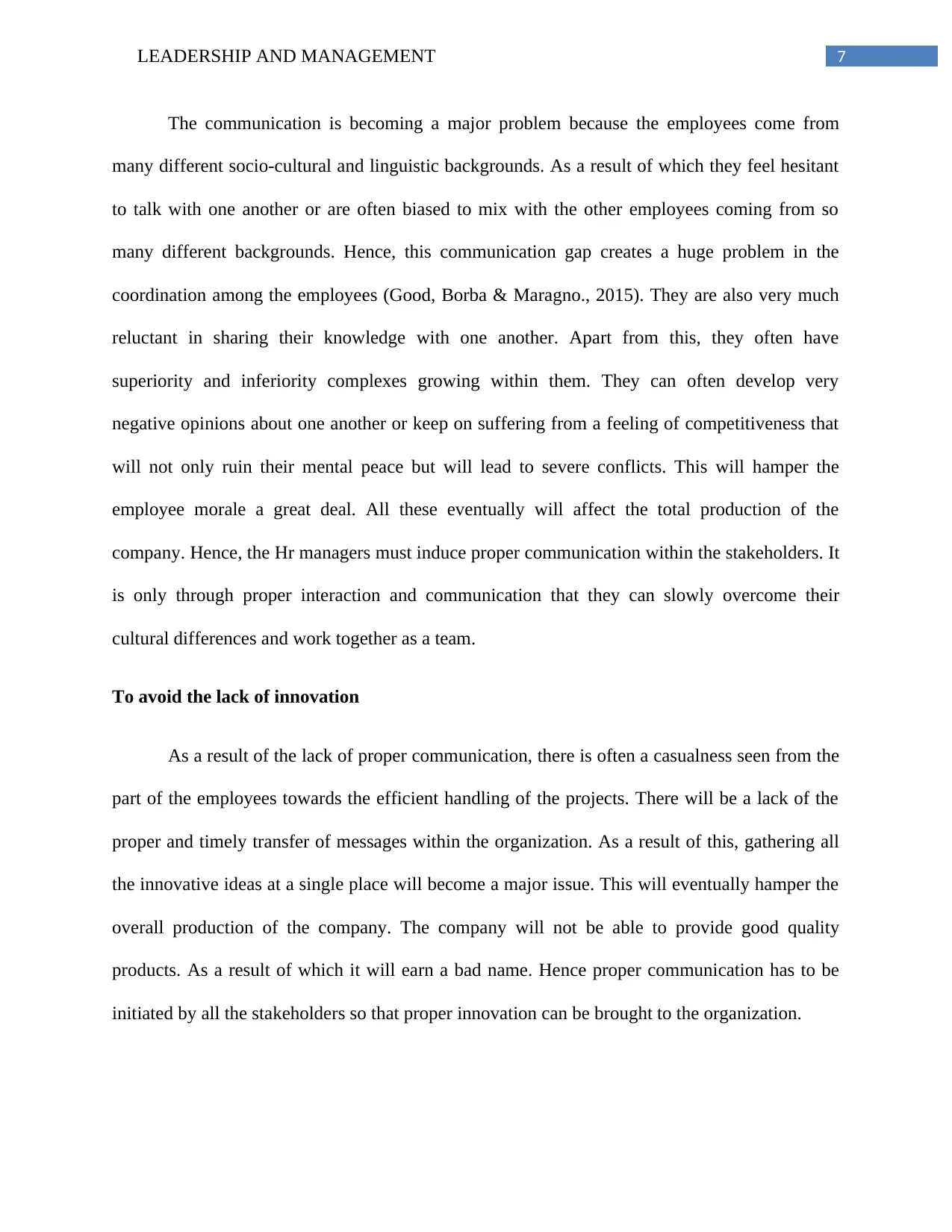
7LEADERSHIP AND MANAGEMENT
The communication is becoming a major problem because the employees come from
many different socio-cultural and linguistic backgrounds. As a result of which they feel hesitant
to talk with one another or are often biased to mix with the other employees coming from so
many different backgrounds. Hence, this communication gap creates a huge problem in the
coordination among the employees (Good, Borba & Maragno., 2015). They are also very much
reluctant in sharing their knowledge with one another. Apart from this, they often have
superiority and inferiority complexes growing within them. They can often develop very
negative opinions about one another or keep on suffering from a feeling of competitiveness that
will not only ruin their mental peace but will lead to severe conflicts. This will hamper the
employee morale a great deal. All these eventually will affect the total production of the
company. Hence, the Hr managers must induce proper communication within the stakeholders. It
is only through proper interaction and communication that they can slowly overcome their
cultural differences and work together as a team.
To avoid the lack of innovation
As a result of the lack of proper communication, there is often a casualness seen from the
part of the employees towards the efficient handling of the projects. There will be a lack of the
proper and timely transfer of messages within the organization. As a result of this, gathering all
the innovative ideas at a single place will become a major issue. This will eventually hamper the
overall production of the company. The company will not be able to provide good quality
products. As a result of which it will earn a bad name. Hence proper communication has to be
initiated by all the stakeholders so that proper innovation can be brought to the organization.
The communication is becoming a major problem because the employees come from
many different socio-cultural and linguistic backgrounds. As a result of which they feel hesitant
to talk with one another or are often biased to mix with the other employees coming from so
many different backgrounds. Hence, this communication gap creates a huge problem in the
coordination among the employees (Good, Borba & Maragno., 2015). They are also very much
reluctant in sharing their knowledge with one another. Apart from this, they often have
superiority and inferiority complexes growing within them. They can often develop very
negative opinions about one another or keep on suffering from a feeling of competitiveness that
will not only ruin their mental peace but will lead to severe conflicts. This will hamper the
employee morale a great deal. All these eventually will affect the total production of the
company. Hence, the Hr managers must induce proper communication within the stakeholders. It
is only through proper interaction and communication that they can slowly overcome their
cultural differences and work together as a team.
To avoid the lack of innovation
As a result of the lack of proper communication, there is often a casualness seen from the
part of the employees towards the efficient handling of the projects. There will be a lack of the
proper and timely transfer of messages within the organization. As a result of this, gathering all
the innovative ideas at a single place will become a major issue. This will eventually hamper the
overall production of the company. The company will not be able to provide good quality
products. As a result of which it will earn a bad name. Hence proper communication has to be
initiated by all the stakeholders so that proper innovation can be brought to the organization.
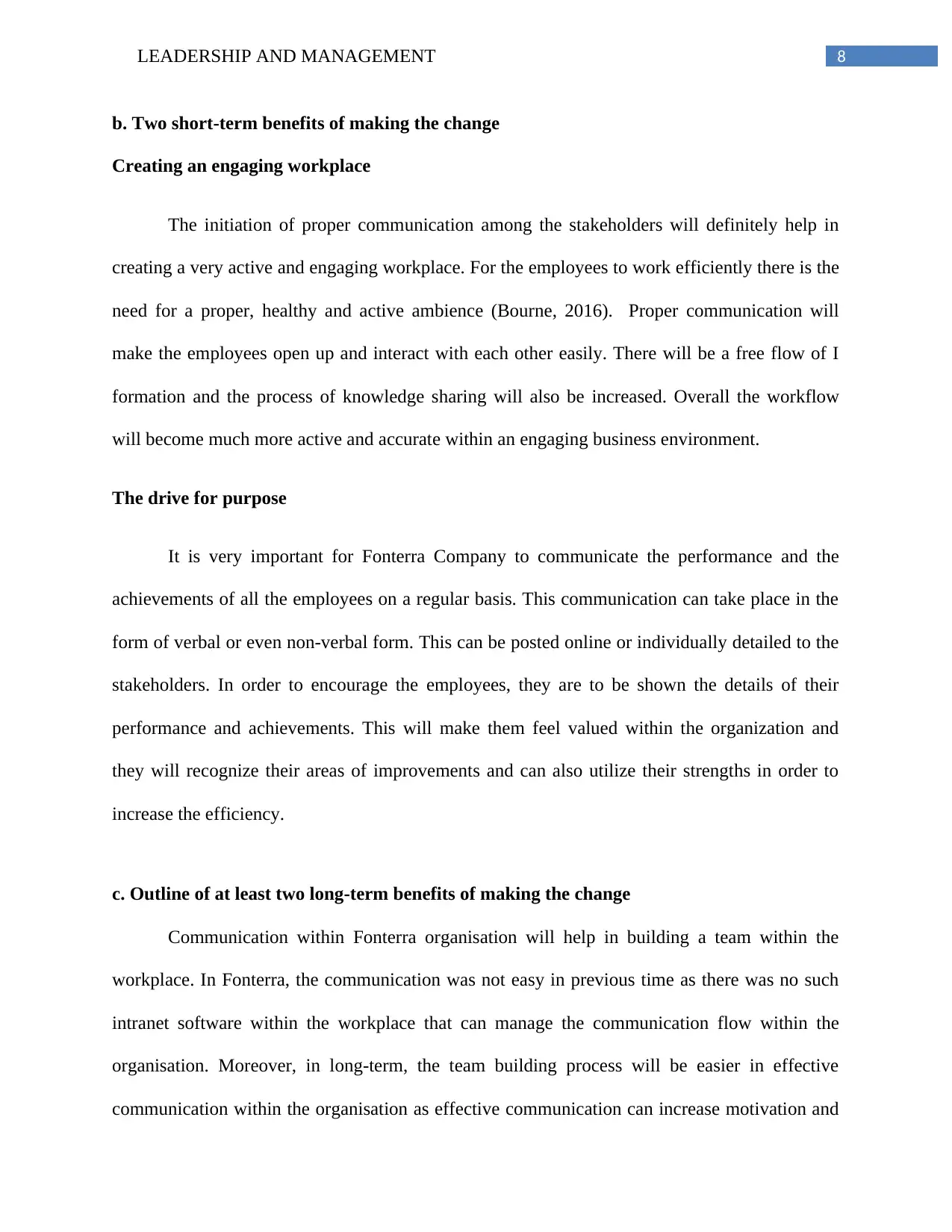
8LEADERSHIP AND MANAGEMENT
b. Two short-term benefits of making the change
Creating an engaging workplace
The initiation of proper communication among the stakeholders will definitely help in
creating a very active and engaging workplace. For the employees to work efficiently there is the
need for a proper, healthy and active ambience (Bourne, 2016). Proper communication will
make the employees open up and interact with each other easily. There will be a free flow of I
formation and the process of knowledge sharing will also be increased. Overall the workflow
will become much more active and accurate within an engaging business environment.
The drive for purpose
It is very important for Fonterra Company to communicate the performance and the
achievements of all the employees on a regular basis. This communication can take place in the
form of verbal or even non-verbal form. This can be posted online or individually detailed to the
stakeholders. In order to encourage the employees, they are to be shown the details of their
performance and achievements. This will make them feel valued within the organization and
they will recognize their areas of improvements and can also utilize their strengths in order to
increase the efficiency.
c. Outline of at least two long-term benefits of making the change
Communication within Fonterra organisation will help in building a team within the
workplace. In Fonterra, the communication was not easy in previous time as there was no such
intranet software within the workplace that can manage the communication flow within the
organisation. Moreover, in long-term, the team building process will be easier in effective
communication within the organisation as effective communication can increase motivation and
b. Two short-term benefits of making the change
Creating an engaging workplace
The initiation of proper communication among the stakeholders will definitely help in
creating a very active and engaging workplace. For the employees to work efficiently there is the
need for a proper, healthy and active ambience (Bourne, 2016). Proper communication will
make the employees open up and interact with each other easily. There will be a free flow of I
formation and the process of knowledge sharing will also be increased. Overall the workflow
will become much more active and accurate within an engaging business environment.
The drive for purpose
It is very important for Fonterra Company to communicate the performance and the
achievements of all the employees on a regular basis. This communication can take place in the
form of verbal or even non-verbal form. This can be posted online or individually detailed to the
stakeholders. In order to encourage the employees, they are to be shown the details of their
performance and achievements. This will make them feel valued within the organization and
they will recognize their areas of improvements and can also utilize their strengths in order to
increase the efficiency.
c. Outline of at least two long-term benefits of making the change
Communication within Fonterra organisation will help in building a team within the
workplace. In Fonterra, the communication was not easy in previous time as there was no such
intranet software within the workplace that can manage the communication flow within the
organisation. Moreover, in long-term, the team building process will be easier in effective
communication within the organisation as effective communication can increase motivation and
⊘ This is a preview!⊘
Do you want full access?
Subscribe today to unlock all pages.

Trusted by 1+ million students worldwide
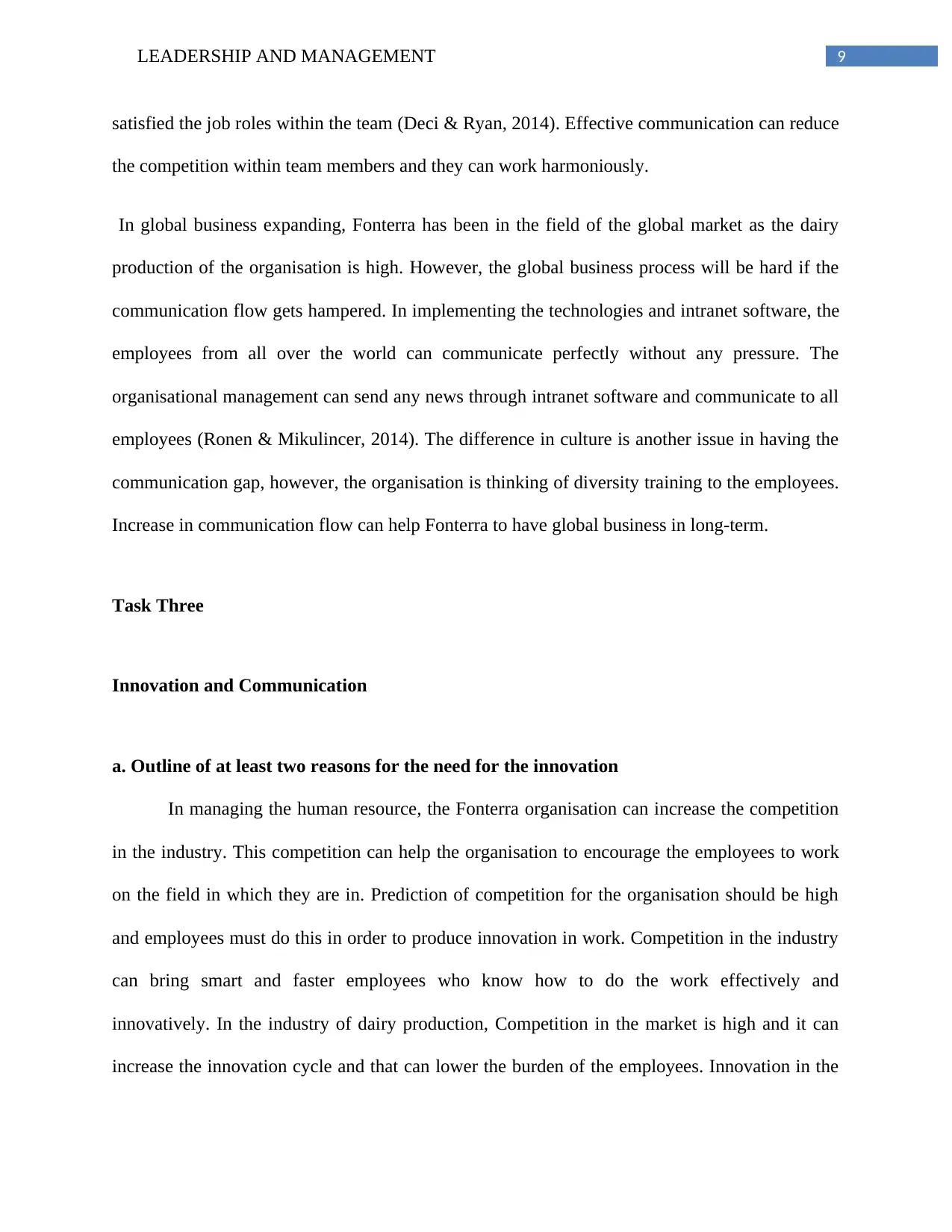
9LEADERSHIP AND MANAGEMENT
satisfied the job roles within the team (Deci & Ryan, 2014). Effective communication can reduce
the competition within team members and they can work harmoniously.
In global business expanding, Fonterra has been in the field of the global market as the dairy
production of the organisation is high. However, the global business process will be hard if the
communication flow gets hampered. In implementing the technologies and intranet software, the
employees from all over the world can communicate perfectly without any pressure. The
organisational management can send any news through intranet software and communicate to all
employees (Ronen & Mikulincer, 2014). The difference in culture is another issue in having the
communication gap, however, the organisation is thinking of diversity training to the employees.
Increase in communication flow can help Fonterra to have global business in long-term.
Task Three
Innovation and Communication
a. Outline of at least two reasons for the need for the innovation
In managing the human resource, the Fonterra organisation can increase the competition
in the industry. This competition can help the organisation to encourage the employees to work
on the field in which they are in. Prediction of competition for the organisation should be high
and employees must do this in order to produce innovation in work. Competition in the industry
can bring smart and faster employees who know how to do the work effectively and
innovatively. In the industry of dairy production, Competition in the market is high and it can
increase the innovation cycle and that can lower the burden of the employees. Innovation in the
satisfied the job roles within the team (Deci & Ryan, 2014). Effective communication can reduce
the competition within team members and they can work harmoniously.
In global business expanding, Fonterra has been in the field of the global market as the dairy
production of the organisation is high. However, the global business process will be hard if the
communication flow gets hampered. In implementing the technologies and intranet software, the
employees from all over the world can communicate perfectly without any pressure. The
organisational management can send any news through intranet software and communicate to all
employees (Ronen & Mikulincer, 2014). The difference in culture is another issue in having the
communication gap, however, the organisation is thinking of diversity training to the employees.
Increase in communication flow can help Fonterra to have global business in long-term.
Task Three
Innovation and Communication
a. Outline of at least two reasons for the need for the innovation
In managing the human resource, the Fonterra organisation can increase the competition
in the industry. This competition can help the organisation to encourage the employees to work
on the field in which they are in. Prediction of competition for the organisation should be high
and employees must do this in order to produce innovation in work. Competition in the industry
can bring smart and faster employees who know how to do the work effectively and
innovatively. In the industry of dairy production, Competition in the market is high and it can
increase the innovation cycle and that can lower the burden of the employees. Innovation in the
Paraphrase This Document
Need a fresh take? Get an instant paraphrase of this document with our AI Paraphraser
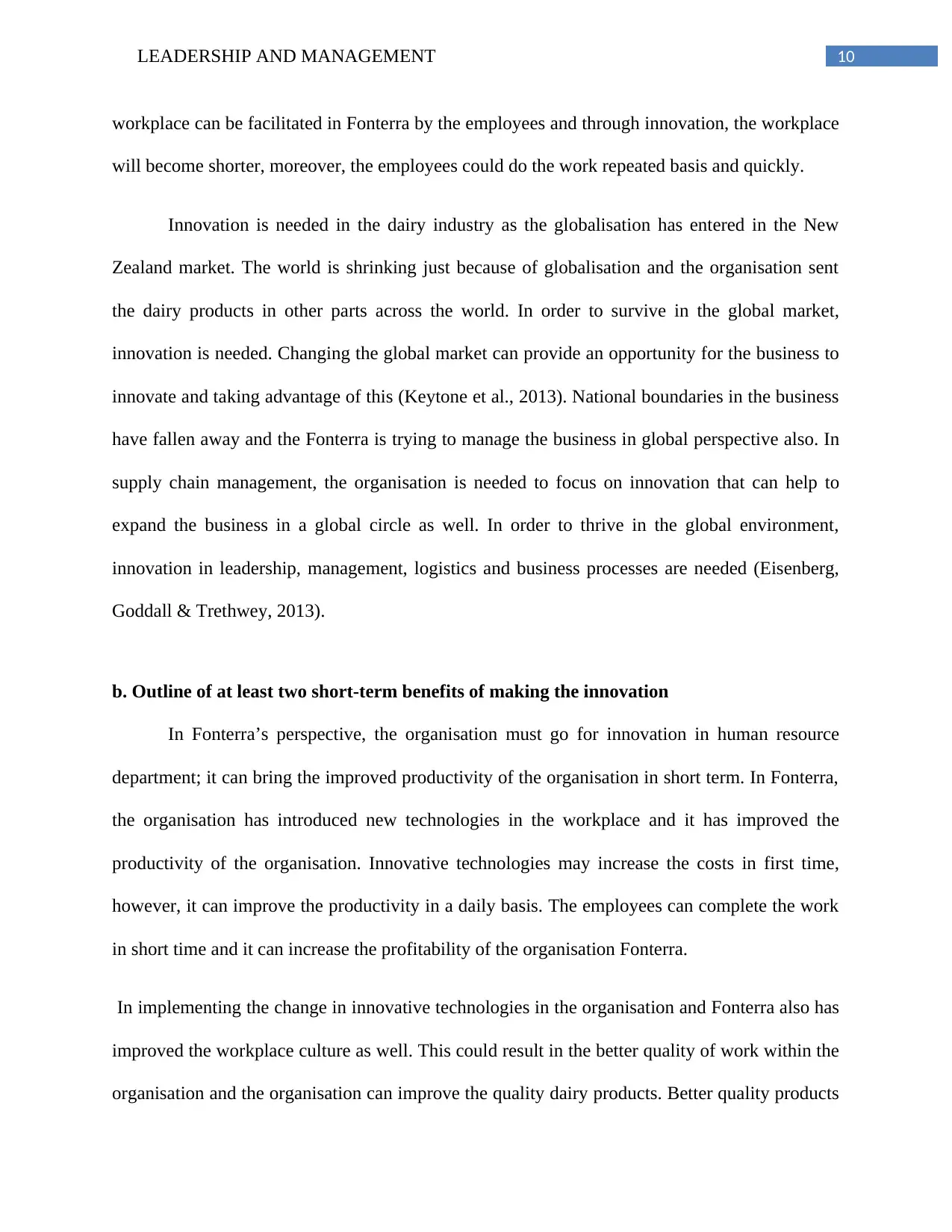
10LEADERSHIP AND MANAGEMENT
workplace can be facilitated in Fonterra by the employees and through innovation, the workplace
will become shorter, moreover, the employees could do the work repeated basis and quickly.
Innovation is needed in the dairy industry as the globalisation has entered in the New
Zealand market. The world is shrinking just because of globalisation and the organisation sent
the dairy products in other parts across the world. In order to survive in the global market,
innovation is needed. Changing the global market can provide an opportunity for the business to
innovate and taking advantage of this (Keytone et al., 2013). National boundaries in the business
have fallen away and the Fonterra is trying to manage the business in global perspective also. In
supply chain management, the organisation is needed to focus on innovation that can help to
expand the business in a global circle as well. In order to thrive in the global environment,
innovation in leadership, management, logistics and business processes are needed (Eisenberg,
Goddall & Trethwey, 2013).
b. Outline of at least two short-term benefits of making the innovation
In Fonterra’s perspective, the organisation must go for innovation in human resource
department; it can bring the improved productivity of the organisation in short term. In Fonterra,
the organisation has introduced new technologies in the workplace and it has improved the
productivity of the organisation. Innovative technologies may increase the costs in first time,
however, it can improve the productivity in a daily basis. The employees can complete the work
in short time and it can increase the profitability of the organisation Fonterra.
In implementing the change in innovative technologies in the organisation and Fonterra also has
improved the workplace culture as well. This could result in the better quality of work within the
organisation and the organisation can improve the quality dairy products. Better quality products
workplace can be facilitated in Fonterra by the employees and through innovation, the workplace
will become shorter, moreover, the employees could do the work repeated basis and quickly.
Innovation is needed in the dairy industry as the globalisation has entered in the New
Zealand market. The world is shrinking just because of globalisation and the organisation sent
the dairy products in other parts across the world. In order to survive in the global market,
innovation is needed. Changing the global market can provide an opportunity for the business to
innovate and taking advantage of this (Keytone et al., 2013). National boundaries in the business
have fallen away and the Fonterra is trying to manage the business in global perspective also. In
supply chain management, the organisation is needed to focus on innovation that can help to
expand the business in a global circle as well. In order to thrive in the global environment,
innovation in leadership, management, logistics and business processes are needed (Eisenberg,
Goddall & Trethwey, 2013).
b. Outline of at least two short-term benefits of making the innovation
In Fonterra’s perspective, the organisation must go for innovation in human resource
department; it can bring the improved productivity of the organisation in short term. In Fonterra,
the organisation has introduced new technologies in the workplace and it has improved the
productivity of the organisation. Innovative technologies may increase the costs in first time,
however, it can improve the productivity in a daily basis. The employees can complete the work
in short time and it can increase the profitability of the organisation Fonterra.
In implementing the change in innovative technologies in the organisation and Fonterra also has
improved the workplace culture as well. This could result in the better quality of work within the
organisation and the organisation can improve the quality dairy products. Better quality products
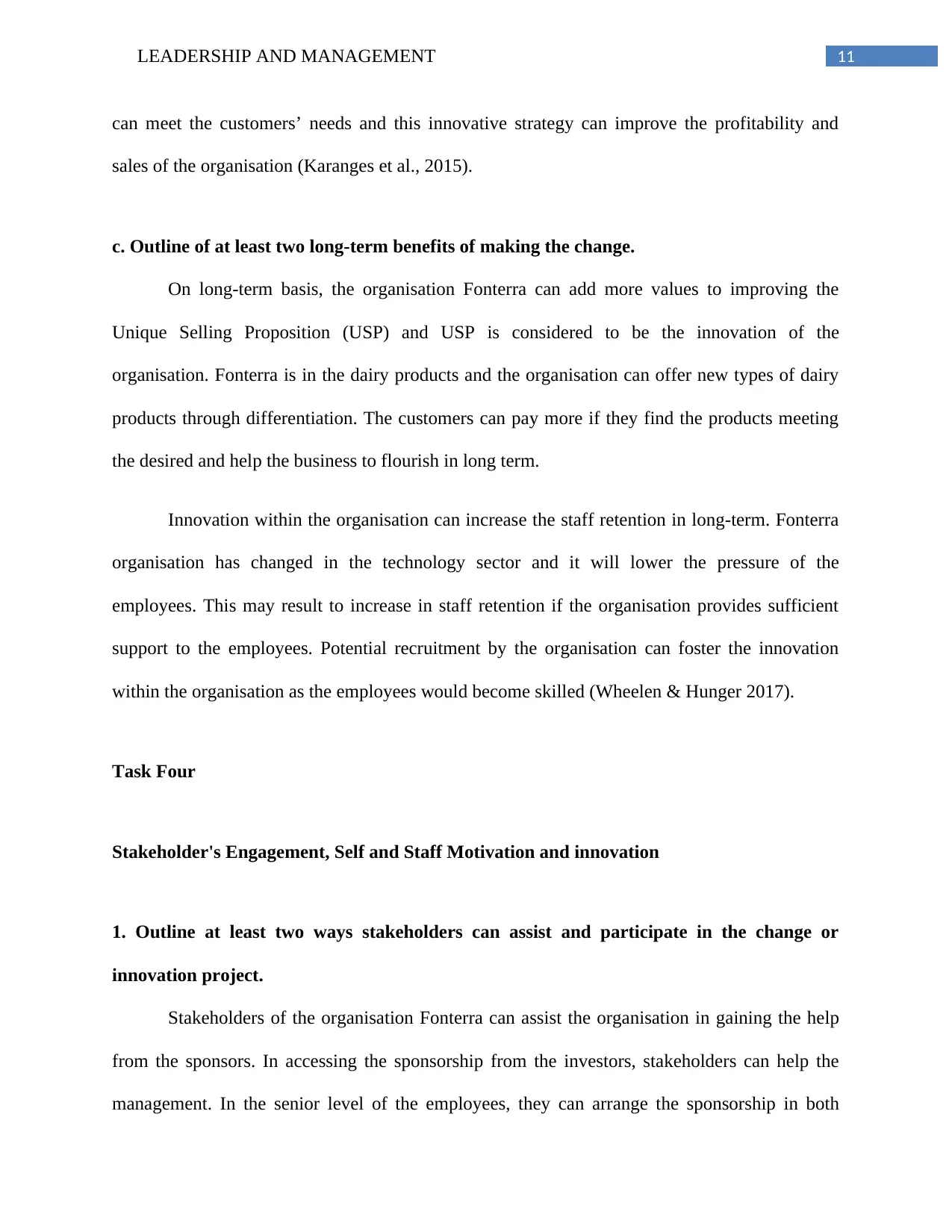
11LEADERSHIP AND MANAGEMENT
can meet the customers’ needs and this innovative strategy can improve the profitability and
sales of the organisation (Karanges et al., 2015).
c. Outline of at least two long-term benefits of making the change.
On long-term basis, the organisation Fonterra can add more values to improving the
Unique Selling Proposition (USP) and USP is considered to be the innovation of the
organisation. Fonterra is in the dairy products and the organisation can offer new types of dairy
products through differentiation. The customers can pay more if they find the products meeting
the desired and help the business to flourish in long term.
Innovation within the organisation can increase the staff retention in long-term. Fonterra
organisation has changed in the technology sector and it will lower the pressure of the
employees. This may result to increase in staff retention if the organisation provides sufficient
support to the employees. Potential recruitment by the organisation can foster the innovation
within the organisation as the employees would become skilled (Wheelen & Hunger 2017).
Task Four
Stakeholder's Engagement, Self and Staff Motivation and innovation
1. Outline at least two ways stakeholders can assist and participate in the change or
innovation project.
Stakeholders of the organisation Fonterra can assist the organisation in gaining the help
from the sponsors. In accessing the sponsorship from the investors, stakeholders can help the
management. In the senior level of the employees, they can arrange the sponsorship in both
can meet the customers’ needs and this innovative strategy can improve the profitability and
sales of the organisation (Karanges et al., 2015).
c. Outline of at least two long-term benefits of making the change.
On long-term basis, the organisation Fonterra can add more values to improving the
Unique Selling Proposition (USP) and USP is considered to be the innovation of the
organisation. Fonterra is in the dairy products and the organisation can offer new types of dairy
products through differentiation. The customers can pay more if they find the products meeting
the desired and help the business to flourish in long term.
Innovation within the organisation can increase the staff retention in long-term. Fonterra
organisation has changed in the technology sector and it will lower the pressure of the
employees. This may result to increase in staff retention if the organisation provides sufficient
support to the employees. Potential recruitment by the organisation can foster the innovation
within the organisation as the employees would become skilled (Wheelen & Hunger 2017).
Task Four
Stakeholder's Engagement, Self and Staff Motivation and innovation
1. Outline at least two ways stakeholders can assist and participate in the change or
innovation project.
Stakeholders of the organisation Fonterra can assist the organisation in gaining the help
from the sponsors. In accessing the sponsorship from the investors, stakeholders can help the
management. In the senior level of the employees, they can arrange the sponsorship in both
⊘ This is a preview!⊘
Do you want full access?
Subscribe today to unlock all pages.

Trusted by 1+ million students worldwide
1 out of 22
Related Documents
Your All-in-One AI-Powered Toolkit for Academic Success.
+13062052269
info@desklib.com
Available 24*7 on WhatsApp / Email
![[object Object]](/_next/static/media/star-bottom.7253800d.svg)
Unlock your academic potential
Copyright © 2020–2025 A2Z Services. All Rights Reserved. Developed and managed by ZUCOL.





